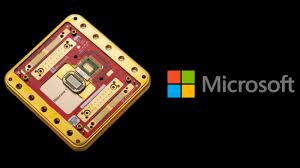Introduction:
Microsoft has taken a bold step into the future of quantum computing. With. It’s built using a brand-new state of matter and a revolutionary material called a topoconductor. The more surprising thing is that this technology was developed from scratch in Microsoft’s labs.
Unlike other quantum chips, Majorana1 is designed to be more stable, less error-prone, and highly scalable. Microsoft claims medicine, climate science, and AI. It sounds like we are stepping toward a new era of technology.

How Majorana1 work:
Majorana1 is an advanced quantum chip that was developed in Microsoft labs, which works on topological qubits – far more stable and error-resistant than traditional qubits used in other quantum computers.”
In other quantum computers that run on qubits, the superpower lies in their ability to use 1, 0, or both at the same time. However, keeping them stable is extremely difficult — even tiny environmental changes can throw them off, leading to high error rates and limited scalability.
Topological qubits use a rare particle called the Majorana Zero mode that stores information in two places; if somehow one gets disturbed, but still not all information is wiped out. it is like storing important documents in two vaults, one is disturbed, the other keeps the documents safe.
Majorana Zero mode:
Majorana zero modes were first predicted in 1937 by physicist Ettore Majorana, who described them as strange and rare quasiparticles — particles that are their own mirror image. In normal quantum computers, qubits are extremely sensitive to even the tiniest environmental changes, such as slight vibrations or temperature shifts, which can disrupt their stability.
The unique advantage of Majorana zero modes lies in their remarkable stability. Unlike regular qubits, they are far less affected by environmental disturbances, making them more reliable for long-term calculations. By developing the Majorana1 chip, Microsoft has taken a major step toward large-scale quantum computers that are both more stable and less error-prone.
How Majorana1 Chip Is Different From Other Quantum Chips:
These days, AI is used in every field to maximize the quality of outcomes; it helps in career dissension, autonomous vehicles, and gaming. On the other hand, quantum science is silently growing. Most quantum chips work on qubits. in classical chips, work on bits means computer use (1 or 0) for calculation, but qubits come as a game-changer because it has the capability to use (1 or 0) or both at the same time. This is the overview of quantum computing. If you want to know more a bout how quantum computers work so click on https://techman.live/what-is-quantum-computer-the-future-of-new-era/. A quantum computer is not a few times faster than a traditional computer; it is a billion times faster. But still qubits most quantum chips today have two main problems — they generate too many errors and can’t be scaled up easily. Imagine trying to build a giant Lego tower, but every time you add more blocks, the whole thing starts wobbling — that’s how most quantum chips behave when you add more qubits.
But we need to accept that “Every groundbreaking technology comes with its own set of challenges — and quantum computing is no exception.” The main challenges in quantum chips come from their core power qubits. they need an environment close to absolute zero (−273°C) to function properly. Qubits are extremely sensitive to their environment. Even the tiniest vibration, change in temperature, or electromagnetic noise can throw them off balance. It’s like trying to keep an ice cube frozen in the middle of the desert -one small change, and it melts away.
However, “every big difficulty is the mother of great innovation.” Majorana1 is one such heroic innovation from Microsoft’s lab, built using topological qubits to perform calculations. Think of it like this: regular qubits are like a house made of sticks and leaves — in a bad environment, they quickly lose balance. But topological qubits are like a strong cement house — stable and resistant to disturbances. While Majorana1 is still in its early stages, in the future, its advanced versions could tackle real-world problems that today’s classical computers can’t touch — such as modeling complex molecules for drug discovery or running climate simulations to fight global warming.
The future of the Majorana1 chip:
The Majorana1 chip is still in its development stage, and like all quantum computers, it faces the challenge of reduced stability, which often results in calculation errors. However, unlike traditional qubits, Majorana1 is built using topological qubits, which are far more stable and produce fewer errors.
In the future, as the Majorana1 chip advances, it could become the backbone of next-generation quantum computers. This would enable scientists to model complex molecules for new medicines, run highly accurate climate simulations to tackle global warming, and develop advanced AI systems that can process and learn from data in ways we can’t yet imagine.
Beyond science, Majorana1 could transform industries such as finance, navigation, material science, and logistics — from creating self-healing materials to designing ultra-efficient routes for ships and airplanes.
Conclusion:
Majorana1 isn’t just a chip — it’s a leap toward the future of quantum computing. With its stable topological qubits and powerful capabilities, it could soon transform science, industry, and AI, solving problems that today’s computers can’t touch. The quantum revolution is closer than we think.
INTERNAL LINKS:
https://techman.live/what-is-quantum-computer-the-future-of-new-era/
https://techman.live/what-is-agentic-ai-and-how-it-different-from-chatgpt/
